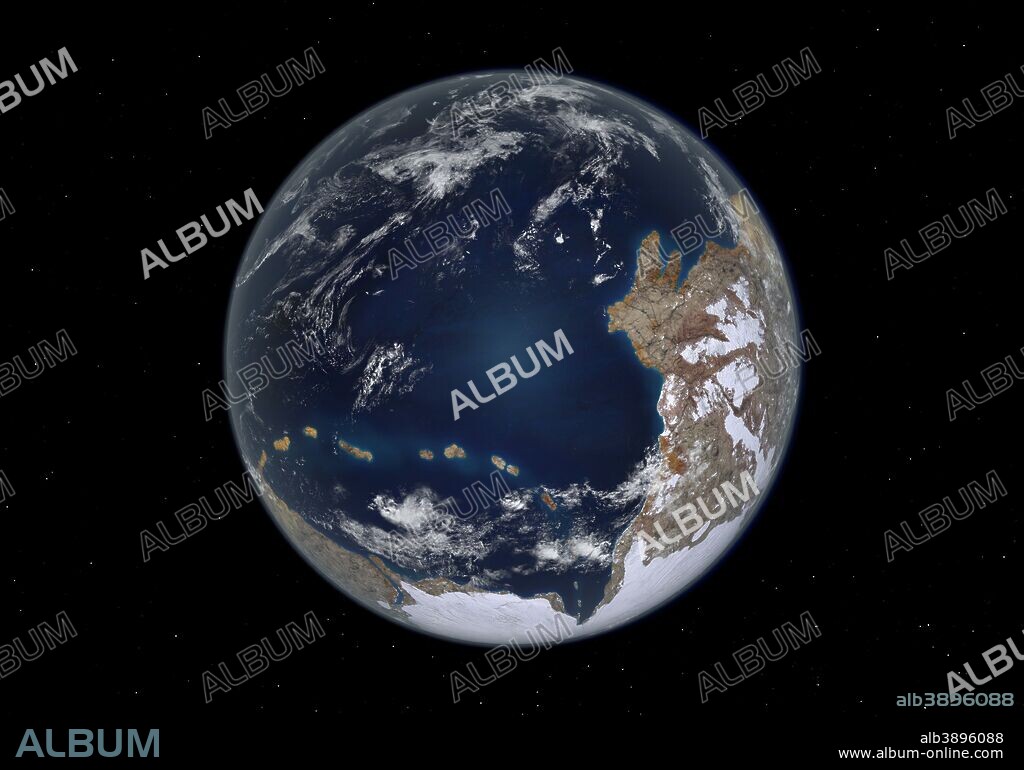alb3896088
Planet Earth 600 million years ago following the Cryogenian period.

|
Add to another lightbox |
|
Add to another lightbox |



Buy this image.
Select the use:

Title:
Planet Earth 600 million years ago following the Cryogenian period.
Caption:
This is how the Earth may have appeared 600 million years ago following the Cryogenian Snowball Earth period. The worldwide glaciers have melted and the ocean is largely liquid again. During this, the Ediacaran period, it is hypothesized that all of the Earth's landmasses had merged into a single supercontinent known as Pannotia, also known as the Vendian supercontinent. Surrounding this massive landmass is the vast Panthalassic Ocean, also known as Panthalassa.. . While the ocean was home to a variety of evolving multicellular life forms including the ubiquitous Dickinsonia costata, it is not believed that life had moved to dry land with possible exception of bacteria and other microbial colonies.
Category:
Space
Credit:
Album / Walter Myers/Stocktrek Images
Releases:
Image size:
5000 x 3500 px | 50.1 MB
Print size:
42.3 x 29.6 cm | 16.7 x 11.7 in (300 dpi)
Keywords:
ASTRONOMIA • ASTRONOMY • BEGINNINGS • CHANGING FORM • COLOR IMAGE • COLOUR IMAGE • CONTINENT • CONTINENTAL DRIFT • CREATION • CRYOGENIAN • EARTH SCIENCE • EARTH • EDIACARAN • EVOLUTION • FAULT • FLEET • FULL EARTH • GEOGRAFIA • GEOGRAPHY • GEOLOGIA • GEOLOGY • GLACIAR • GLACIATION • GLACIER • GLACIOLOGY • GLOBE • HISTORY • HORIZONTAL • ICE AGE • LANDFORM • LANDMASS • LIFE • LITHOSPHERE • MARINE • MERGING • NATURAL HISTORY • NATURAL SCIENCES • NATURE STUDY • NATURE • NAVY • NEOPROTEROZOIC ERA • OCEAN • OCEAN, PACIFIC • OCEANS • ORIGIN • OUTERSPACE • PACIFIC OCEAN • PALEOGEOGRAPHY • PALEOZOIC ERA • PANNOTIA • PANTHALASSA • PANTHALASSIC OCEAN • PAST • PHYSICAL GEOGRAPHY • PLANET • PLANETS • PLATE TECTONICS • PRECAMBRIAN • PREHISTORIC ERA • PROTEROZOIC • ROUND • SCIENCE • SCIENCE: EVOLUTION • SEA • SEA. • SEAFLOOR SPREADING • SEAS • SINGLE OBJECT • SNOWBALL EARTH • SOLAR SYSTEM • SPACE (COSMOS) • SPACE ART • SPACE • SPATIAL • SPHÈRE • SUPERCONTINENT • TECTONOPHYSICS • VENDIAN • WATER • WHOLE • WILDERNESS


 Pinterest
Pinterest Twitter
Twitter Facebook
Facebook Copy link
Copy link Email
Email
